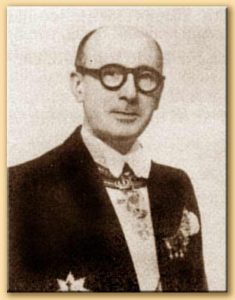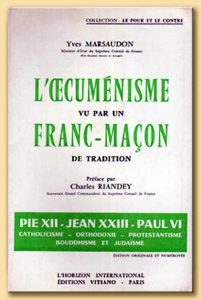Book presentation with Msgr. Weninger on February 12 in Vienna; next to him Georg Semler, the Grand Master of the Grand Lodge of Austria, and on the far left the publisher Georg Löcker - fellow lodge brothers.
Von P. Paolo Maria Siano*
[Katholisches] In 1982 Michael Heinrich Weninger (born 1951 in Wiener Neustadt) joined the diplomatic service of the Republic of Austria, where he had a brilliant career. Among other things, he was from 1993 to 1997 head of the Austrian embassy in Belgrade and from 2008 to 2009 in Sarajevo. [1] Weninger, who has been a widower since 2009, was ordained a priest by Cardinal Christoph Schönborn in Vienna on June 24, 2011. Msgr. Weninger is also a member of the Pontifical Council for Interreligious Dialogue.
In October 2014, the website of the East Lancashire Provincial Grand Lodge of Mark Master Masons (English masonry was founded by the masters of the United Grand Lodge of England - UGLE) announced that a few days earlier, three ceremonies were held in Austria in the presence of an English Masonic delegation Installation by masters. The ceremonies took place in two boxes of the Mark Master Masons (MMM) [2] - in the St. Margaret's Lodge of MMM and the New Quarries Lodge of MMM, which is the oldest English-speaking Mark Master Mason Lodge in Austria - and in a Royal-Ark-Marine Lodge (RAM) held at the New Shores Lodge of RAM. [3] These three Austrian lodges with English names are associated with English Freemasonry and use rituals in English.
In each of these three lodges the "Brother" Msgr. Michael Weninger ("Bro. Rev. Michael Weninger") as chaplain for 2014–2015, who even celebrated a commemorative Mass on the fifth anniversary of the opening of the New Quarries Lodge and St. Margaret’s Lodge. 500 Freemasons of all obediences were present at the Mass. The Masonic website adds that “Bro. Rev. Michael ”(Bro. Stands for “brother ”, that's how the Freemasons call themselves) is well qualified for the position of lodge chaplain, since he lives in the Vatican and works as a member of the Pontifical Council for Interreligious Dialogue:
"Since he lives in the Vatican as a member of the Pontifical Council for Inter-religious Dialogue but works in Rome."
Anyone who knows a little about Masonic matters knows that Msgr. Weninger, in order to be appointed chaplain of a lodge (or rather three lodges), had been initiated as a Mason of the first degree (apprentice) years before, then had to be transferred to the second degree (journeyman) before finally moving to the third degree, the master degree. Then he must have climbed to the higher grades, first as a master mason, then as a Royal Ark Mariner. It cannot be ruled out that he completed other “side degrees”.
It is therefore likely that Msgr. Weninger became a Mason even before he was ordained. I remember years ago someone mentioned the case of a former Austrian diplomat who had joined the Roman Curia as a priest and was considered a member of Freemasonry. It is only now that I have no doubt that this information is factual. And so we come to our days.
On Wednesday, February 12, 2020, Msgr. Michael Heinrich Weninger in Vienna in the presence of Georg Semler, Grand Master of the Grand Lodge of Austria (GLvÖ), presented his 500-page book “Lodge und Altar. On the Reconciliation of the Catholic Church and Regular Freemasonry.” In it he claims (I summarize):
that the Church's rejection of Freemasonry was motivated more by political than religious reasons;
that the Church was unable to distinguish between regular and irregular Freemasonry;
that the freemasons of regular freemasonry (e.g. the UGLE, the GLvÖ etc.) are not excommunicated
and that you can be Catholic and “regular” Freemason.
Msgr. Weninger even sent his book to Pope Francis, Cardinal Schönborn and various Vatican figures. Grand Master Semler praised the book as an important step towards reconciliation between the Church and Freemasonry. [4]
The Freemasons and Msgr. Weninger hope to meet with the Holy Father or with the Prefect of the Congregation for the Doctrine of the Faith. [5]
Dialogue with members of the Catholic hierarchy is not new to Austrian Freemasonry. From 1968 to 1983 the Archbishop of Vienna, Cardinal Franz König, was the protagonist of the dialogues with representatives of Austrian, Swiss and West German Freemasonry, which culminated in the 1970 Lichtenau Declaration in favor of the compatibility of the Catholic Church and regular Freemasonry. It states that the latter is not a danger, which is why excommunication should be lifted.
Later, the German bishops in 1980 and the Congregation for the Doctrine of the Faith in 1981 and 1983 reiterated the incompatibility between the church and the lodge, and that was not for political but for doctrinal reasons, after Masonic writings by members.
Another interesting novelty is that the book by Msgr. Weninger is based on his dissertation, which he submitted to the Pontifical Gregorian University in Rome, with which he received his doctorate and which was published by this university in November 2019. That is its title: “Wisdom. Strength. Beauty. On the reconciliation of the Catholic Church and regular Freemasonry, Tesi Gregoriana (Spiritualità series, 16), PUG 2019, p. 523.
The case of Msgr. Weninger raises a few questions and considerations:
1) Why did this website of the English masonry reveal the Masonic status of Msgr. Weninger, who is so well integrated into the Vatican? Was it an accidental carelessness or a clever display?
2) How long is Msgr Weninger's membership in Freemasonry in the Archdiocese of Vienna and the Roman Curia?
3) How is Msgr. Weninger's canonical position affected by his "coming out"?
4) How do Freemasonic prelates behave towards their subordinates who express amazement and concern about the affiliation of clerics and lay Catholics to Freemasonry?
5) Can the so-called "Masonic regularity" be a criterion for the canonical rehabilitation of Anglo-Saxon Freemasonry? In fact, I find a certain contradiction with the topic of “Masonic regularity.” For example, the United Grand Lodge of England (UGLE) recognizes the Grand Lodge of Austria (GLvÖ) as "regular", which in turn recognizes the Grand Orient of Italy (GOI) as "regular", which the UGLE does not recognize. Now, what credibility can the Grand Lodge of Austria claim before the Roman Curia, since it recognizes the Grand Orient of Italy as "regular", which is clearly a secular and esoteric Freemasonry with a long anti-clerical tradition?
6) Austrian Freemasonry wants a dialogue with the Pope, the Prefect of Faith and other personalities from the Vatican. Good. I hope, however, that the Austrian Freemasonry will not only talk to Msgr. Weninger's book, but also the rituals of the three degrees of apprentice, journeyman and master; the rituals of the high degree rites to which the masters of the Grand Lodges of Austria have access and the esoteric and initiatic writings that are reserved for the Masonic masters (there are, I know that very well).
Only careful review of such extensive documentation can enable ecclesiastical authorities and Catholic scholars to make a real and objective judgment about Freemasonry.
Finally, for reasons of space, I limit myself to this brief information: Regarding the English Master Mark Masonry (MMM) and the Royal Ark Mariner (the RAM level is reserved for MMM), which is connected to the above-mentioned United Grand Lodge of England (UGLE) I know with certainty that even bricklayers of these degrees, who are apparently "biblical", are able to maintain esotericism. The same thing happens in Austrian Freemasonry. Therefore, the statements by Msgr. Weninger is anything but convincing.
* Father Paolo Maria Siano belongs to the Order of the Franciscans of the Immaculate (FFI); the church historian with a doctorate is considered one of the best Catholic experts in Freemasonry, to whom he has dedicated several standard works and numerous essays.
1] Delicate and responsible missions, since from 1991 to 1995 there was war in the crumbling Yugoslavia. This also applies to operations in Sarajevo, the formal capital of the EU protectorate of Bosnia and Herzegovina and the de facto capital of the Federation of Bosnia and Herzegovina, in which Muslim Bosniaks and Catholic Croats have been united since 1996.
Austrian diplomacy emphatically supported this compulsory situation, as if trying to force “fraternity” in an experiment.
2] The Mark Masonry originated in England in 1756. This makes the mark master degree one of the oldest freemason degrees. It was only introduced in Austria in 2009.
[3] The Royal-Ark Mariner-Logen (RAM) and the Mark Master Masonry (MMM) are part of the Anglo-Saxon high degree system, with the RAM standing above the MMM. Both MMM and RAM degrees accept masters of all creeds, while certain obediences only allow "Trinitarian Christians".
[4] The Grand Master said: "This book is very important. Even if there is practically no longer any conflict with the Church, we in the Grand Lodge have a vital interest in making a gesture of reconciliation. ”
[5] A few days ago, the online Freemason encyclopedia Freemason Wiki published a detailed review of the Weninger book and the following note: "How important Weninger's book is taken internationally is shown by two events: Christoph Bosbach, Grand Master of the United Grand Lodges of Germany, on the book presentation" traveled specially from Catholic Cologne ". And more importantly, when the Pontifical Gregorian University learned of his research there, he explicitly encouraged the author to submit the book to her as a dissertation. The Gregoriana is run by Jesuits; the current Pope Francis is also one. "




















